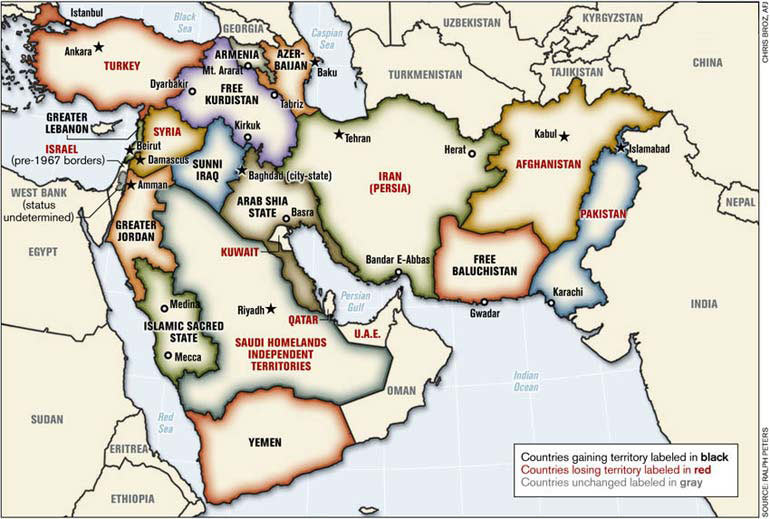The Lebanese Druze leader – who fought in a 15-year civil war that redrew the map of Lebanon – believes that the new battles for Sunni Muslim jihadi control of northern and eastern Syria and western Iraq have finally destroyed the post-World War Anglo-French conspiracy, hatched by Mark Sykes and François Picot, which divided up the old Ottoman Middle East into Arab statelets controlled by the West.
The Islamic Caliphate of Iraq and Syria has been fought into existence – however temporarily – by al-Qa’ida-affiliated Sunni fighters who pay no attention to the artificial borders of Syria, Iraq, Lebanon or Jordan, or even mandate Palestine, created by the British and French. Their capture of the city of Mosul only emphasises the collapse of the secret partition plan which the Allies drew up in the First World War – for Mosul was sought after for its oil wealth by both Britain and France.
The entire Middle East has been haunted by the Sykes-Picot agreement, which also allowed Britain to implement Foreign Secretary Arthur Balfour’s 1917 promise to give British support to the creation of a Jewish “homeland” in Palestine. Perhaps only today’s Arabs (and Israelis) fully understand the profound historical changes – and deep political significance – that the extraordinary battles of this past week have wrought on the old colonial map of the Middle East.
The collapsing Ottoman Empire of 1918 was to be split into two on a north-east, south-west axis which would run roughly from near Kirkuk – today under Kurdish control – across from Mosul in northern Iraq and the Syrian desert and through what is now the West Bank to Gaza. Mosul was initially given to the French – its oil surrendered by the British in return for what would become a French buffer zone between Britain and the Russian Caucasus, Baghdad and Basra being safe in British hands below the French lines. But growing British commercial desires for oil took over from imperial agreements. Mosul was configured into the British zone inside the new state of Iraq (previously Mesopotamia), its oil supplies safely in the hands of London. Iraq, Trans- jordan and Palestine were under British mandatory control, Syria and Lebanon under the French mandate.
But the new geographical map created by al-Qa’ida and its Nusra and Isis allies runs not north-east to south-west but east to west, taking in the cities of Fallujah, Tikrit and Mosul, and Raqqa and large areas of eastern Syria. Jihadi tactics strongly suggest that the line was intended to run from west of Baghdad right across the Iraqi and Syrian deserts to include Homs, Hama and Aleppo in Iraq. But the Syrian government army – successfully fighting a near-identical battle to that now involving a demoralised Iraqi army – has recaptured Homs, held on to Hama and relieved the siege of Aleppo.
By chance, economist Ian Rutledge has just published an account of the battle for Mosul and oil during and after the First World War, and of the betrayal of the Sunni Muslim Sharif Hussein of Mecca, who was promised an independent Arab land by the British in return for his help in overthrowing the Ottoman Empire. Rutledge has researched Britain’s concern about Shia power in southern Iraq – where Basra’s oil lies – material with acute relevance to the crisis now tearing Iraq to pieces.
 Volunteers join the Iraqi army in Baghdad
Volunteers join the Iraqi army in Baghdad
Photo by: AP
For the successor power to Sharif Hussein in Arabia is the Saudi royal family, which has been channelling billions of dollars to the very same jihadi groups that have taken over eastern Syria and western Iraq and now Mosul and Tikrit. The Saudis set themselves up as the foundational Sunni power in the region, controlling Arab Gulf oil wealth – until America’s overthrow of the Sunni dictator Saddam Hussein led inexorably to a majority Shia government in Baghdad allied to Shia Iran.
Thus the new Middle Eastern map substantially increases Saudi power over the region’s oil, lowering Iraq’s exports, raising the cost of oil (including, of course, Saudi oil) and at the expense of a frightened and still sanctioned Iran, which must defend its co-religionists in the collapsing Baghdad government. Mosul’s oil is now Sunni oil. And the vast and unexplored reserves believed to lie beneath the jihadi-held deserts west of Baghdad are now also firmly in Sunni rather than in national, Shia-controlled Baghdad government hands.
 Rebels parade through Mosul
Rebels parade through Mosul
Photo by: Reuters
This break-up may also, of course, engender a new version of the terrifying Iran-Iraq war – a conflict that killed 1.5 million Sunni and Shia Muslims, both sides armed by outside powers while the Arab Gulf states funded the Sunni leadership of Saddam. The West was happy to see these great Muslim powers fighting each other. Israel sent weapons to Iran and watched its principal Muslim enemies destroy each other. Which is why Walid Jumblatt now also believes that the current tragedy – while it has killed off Mr Sykes and Mr Picot – will have Arthur Balfour smiling in his grave.




